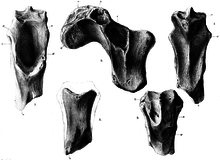| Craterosaurus | |
|---|---|

| |
| Holotype neural arch of C. pottonensis as seen from multiple angles | |
| Scientific classification | |
| Domain: | Eukaryota |
| Kingdom: | Animalia |
| Phylum: | Chordata |
| Clade: | Dinosauria |
| Clade: | †Ornithischia |
| Clade: | †Thyreophora |
| Clade: | †Stegosauria |
| Genus: | †Craterosaurus Seeley, 1874 |
| Species: | †C. pottonensis
|
| Binomial name | |
| †Craterosaurus pottonensis Seeley 1874
| |
Craterosaurus (meaning krater reptile or bowl reptile) was a genus of stegosaurid dinosaur. It lived during the Early Cretaceous (Aptian to Albian stages) around 121-113 million years ago. Its fossils were found in the Woburn Sands Formation of England. Craterosaurus may actually be a junior synonym of Regnosaurus,[1] but only one fossil, a partial vertebra, was recovered.
The holotype was discovered near Potton by a Mr. Charlesworth, and the type (and only known) species is Craterosaurus pottonensis, described in 1874 by Harry Seeley.[2] The specific name refers to the Potton bonebed. Seeley mistook the fossil, holotype SMC B.28814, for the base of a cranium. Franz Nopcsa in 1912 correctly identified it as the front part of a neural arch.[3] Craterosaurus was placed in Stegosauria by Galton,[4] although subsequent authors did not recognize Craterosaurus as a distinct, valid taxon.[5][6]

- ^ Parker, Steve. Dinosaurus: the complete guide to dinosaurs. Firefly Books Inc, 2003. Pg. 348
- ^ Seeley, H.G. (1874). "On the base of a large lacertian cranium from the Potton Sands, presumably dinosaurian". Quarterly Journal of the Geological Society of London. 30 (1–4): 690–692. doi:10.1144/GSL.JGS.1874.030.01-04.62. S2CID 130042940.
- ^ Nopcsa, F., 1912, "Notes on British dinosaurs. Pt. IV. Craterosaurus (Seeley)", Geological Magazine, (ser. 5), 9: 481-484
- ^ Galton, P. (1981). "Craterosaurus pottonensis Seeley, a stegosaurian dinosaur from the Lower Cretaceous of England, and a review of Cretaceous stegosaurs". Neues Jahrbuch für Geologie und Paläontologie, Abhandlungen. 161 (1): 28–46. doi:10.1127/njgpa/161/1981/28.
- ^ Maidment, Susannah C. R.; Norman, David B.; Barrett, Paul M.; Upchurch, Paul (January 2008). "Systematics and phylogeny of Stegosauria (Dinosauria: Ornithischia)". Journal of Systematic Palaeontology. 6 (4): 367–407. Bibcode:2008JSPal...6..367M. doi:10.1017/S1477201908002459. S2CID 85673680.
- ^ Maidment, Susannah C. R. (2010). "Stegosauria: a historical review of the body fossil record and phylogenetic relationships". Swiss Journal of Geosciences. 103 (2): 199–210. Bibcode:2010SwJG..103..199M. doi:10.1007/s00015-010-0023-3. S2CID 84415016.